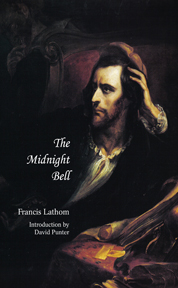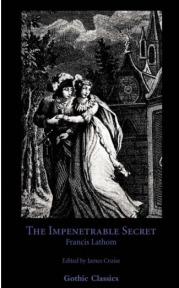
The Fatal Vow; or, St. Michael's Monastery (1807)
Francis Lathom, Edited by Max Fincher
After a falling-out with his father, Reginald de Brune travels to St. Michael's Monastery for a short stay. There, one night at midnight, he observes a beautiful young woman, Christabelle, swearing a mysterious vow at the altar. The two quickly fall in love, but Christabelle's father has other plans, deciding to immure her in a convent, where she is terrorized by a cruel abbess.
But there is more to both Reginald and Christabelle than meets the eye, and quickly the two find themselves caught up in the intrigues of Henry II, his queen, Eleanor of Aquitaine, and their two warring sons, Princes Richard and John. Can the two lovers unravel the mysteries that surround their origins and survive the plots of their enemies?
The Fatal Vow; or, St. Michael's Monastery (1807) is an inventive mix of an early historical novel with aspects of Gothic terror that remains thrilling even two centuries after its first publication. This edition reprints the unabridged text of the very rare first edition, of which fewer than five copies are known to survive worldwide. Also featured are a new introduction and notes by Gothic scholar Max Fincher.
Francis Lathom, Edited by Max Fincher
After a falling-out with his father, Reginald de Brune travels to St. Michael's Monastery for a short stay. There, one night at midnight, he observes a beautiful young woman, Christabelle, swearing a mysterious vow at the altar. The two quickly fall in love, but Christabelle's father has other plans, deciding to immure her in a convent, where she is terrorized by a cruel abbess.
But there is more to both Reginald and Christabelle than meets the eye, and quickly the two find themselves caught up in the intrigues of Henry II, his queen, Eleanor of Aquitaine, and their two warring sons, Princes Richard and John. Can the two lovers unravel the mysteries that surround their origins and survive the plots of their enemies?
The Fatal Vow; or, St. Michael's Monastery (1807) is an inventive mix of an early historical novel with aspects of Gothic terror that remains thrilling even two centuries after its first publication. This edition reprints the unabridged text of the very rare first edition, of which fewer than five copies are known to survive worldwide. Also featured are a new introduction and notes by Gothic scholar Max Fincher.
|
BOOK DETAILS
Hardcover with dust jacket ISBN-13: 978-1934555880 List Price: $39.99 U.S. Pages: 274 Published: 2011 |
|
ALSO AVAILABLE THROUGH ONLINE RETAILERS
MORE TITLES BY THIS AUTHOR
SEE THE COMPLETE LIST OF TITLES HERE
AUTHOR BIOGRAPHY
Francis Lathom (1774-1832) was born in July 1774 at Rotterdam to Henry and Sarah Lathom. Henry Lathom was a Norwich merchant engaged in business with the East India Company in Holland. Around 1777, the family returned to the vicinity of Norwich, and in the 1790s Lathom began to pen plays for the Theatre Royal Norwich, including the comedies All in a Bustle (1795) and The Dash of the Day (1800), the latter of which was acted to “universal applause” and ran into at least four editions. In 1795, Lathom published his first novel, The Castle of Ollada, a Gothic romance indebted to Ann Radcliffe’s The Mysteries of Udolpho (1794) and Walpole’s The Castle of Otranto (1764).
In 1797, Lathom married Diana Ganning, daughter of Daniel Ganning, a wealthy lawyer and landowner, with whom he had three children, Henry Daniel (b. 1799), Frederick (b. 1800), and Jessy Ann (b. 1803). The following year, he published what became his most famous novel, The Midnight Bell (1798), which was mentioned in Jane Austen’s Northanger Abbey (1818) and which was the only of Lathom’s novels reprinted in the 20th century. He followed this success with the satire Men and Manners (1799), described by critic Montague Summers as Lathom’s masterpiece and worthy of a young Dickens, and Mystery (1800), a curious mixture of the Gothic with epistolary domestic romance.
Around 1802 or 1803, under circumstances not yet known, Lathom left Norwich, perhaps for Scotland. Lathom’s father’s will provided him an annuity of £200 per year, provided that he relinquish custody of his children to Diana and have nothing more to do with them. Summers posited that Lathom’s removal from Norwich may have stemmed from a gay love affair, which, while not substantiated, may nonetheless be true.
Between 1802 and 1809, Lathom was extremely prolific, publishing the novels Astonishment!!! (1802), The Impenetrable Secret, Find it Out! (1805), The Mysterious Freebooter (1806), Human Beings (1807), The Fatal Vow (1807), The Unknown (1808), London, or, Truth Without Treason (1809), and The Romance of the Hebrides, or, Wonders Never Cease (1809). After 1809, he disappeared from the publishing scene and apparently travelled to America, where he visited New York and lived for a time in Philadelphia.
In 1820, Lathom returned to publishing, releasing Italian Mysteries and the collection The One-Pound Note and Other Tales. He continued to write throughout the remainder of the decade; these later works include Live and Learn (1823), in which the friendship between the two male characters was felt by Summers to be “clearly” queer in nature, as well as two additional collections of short stories and the novels Young John Bull (1828) and Mystic Events (1830). Lathom is said to have died in Fyvie, Aberdeenshire, Scotland in 1832.
In 1797, Lathom married Diana Ganning, daughter of Daniel Ganning, a wealthy lawyer and landowner, with whom he had three children, Henry Daniel (b. 1799), Frederick (b. 1800), and Jessy Ann (b. 1803). The following year, he published what became his most famous novel, The Midnight Bell (1798), which was mentioned in Jane Austen’s Northanger Abbey (1818) and which was the only of Lathom’s novels reprinted in the 20th century. He followed this success with the satire Men and Manners (1799), described by critic Montague Summers as Lathom’s masterpiece and worthy of a young Dickens, and Mystery (1800), a curious mixture of the Gothic with epistolary domestic romance.
Around 1802 or 1803, under circumstances not yet known, Lathom left Norwich, perhaps for Scotland. Lathom’s father’s will provided him an annuity of £200 per year, provided that he relinquish custody of his children to Diana and have nothing more to do with them. Summers posited that Lathom’s removal from Norwich may have stemmed from a gay love affair, which, while not substantiated, may nonetheless be true.
Between 1802 and 1809, Lathom was extremely prolific, publishing the novels Astonishment!!! (1802), The Impenetrable Secret, Find it Out! (1805), The Mysterious Freebooter (1806), Human Beings (1807), The Fatal Vow (1807), The Unknown (1808), London, or, Truth Without Treason (1809), and The Romance of the Hebrides, or, Wonders Never Cease (1809). After 1809, he disappeared from the publishing scene and apparently travelled to America, where he visited New York and lived for a time in Philadelphia.
In 1820, Lathom returned to publishing, releasing Italian Mysteries and the collection The One-Pound Note and Other Tales. He continued to write throughout the remainder of the decade; these later works include Live and Learn (1823), in which the friendship between the two male characters was felt by Summers to be “clearly” queer in nature, as well as two additional collections of short stories and the novels Young John Bull (1828) and Mystic Events (1830). Lathom is said to have died in Fyvie, Aberdeenshire, Scotland in 1832.




